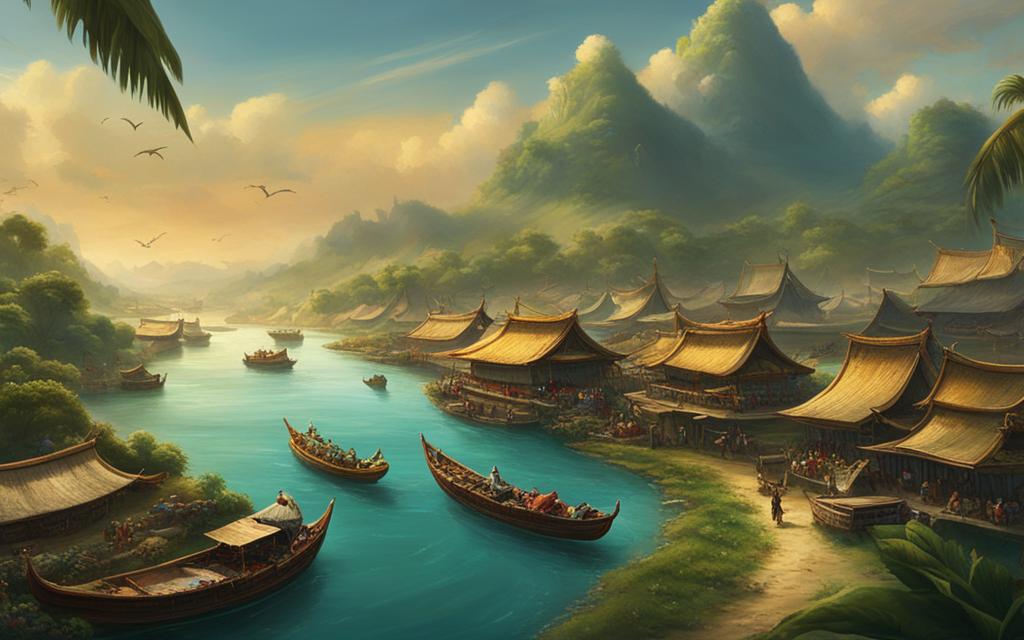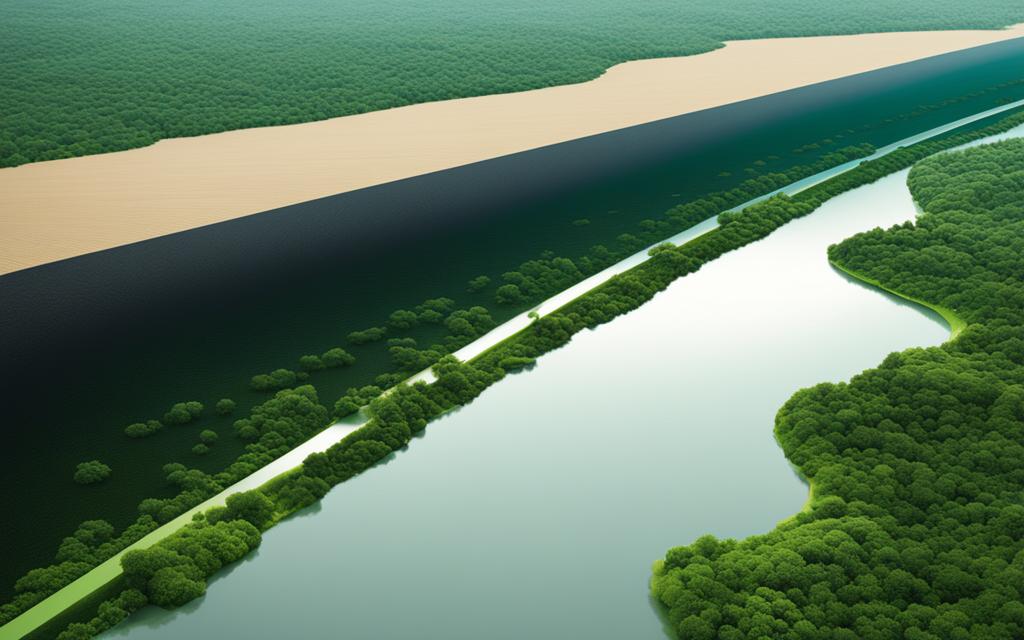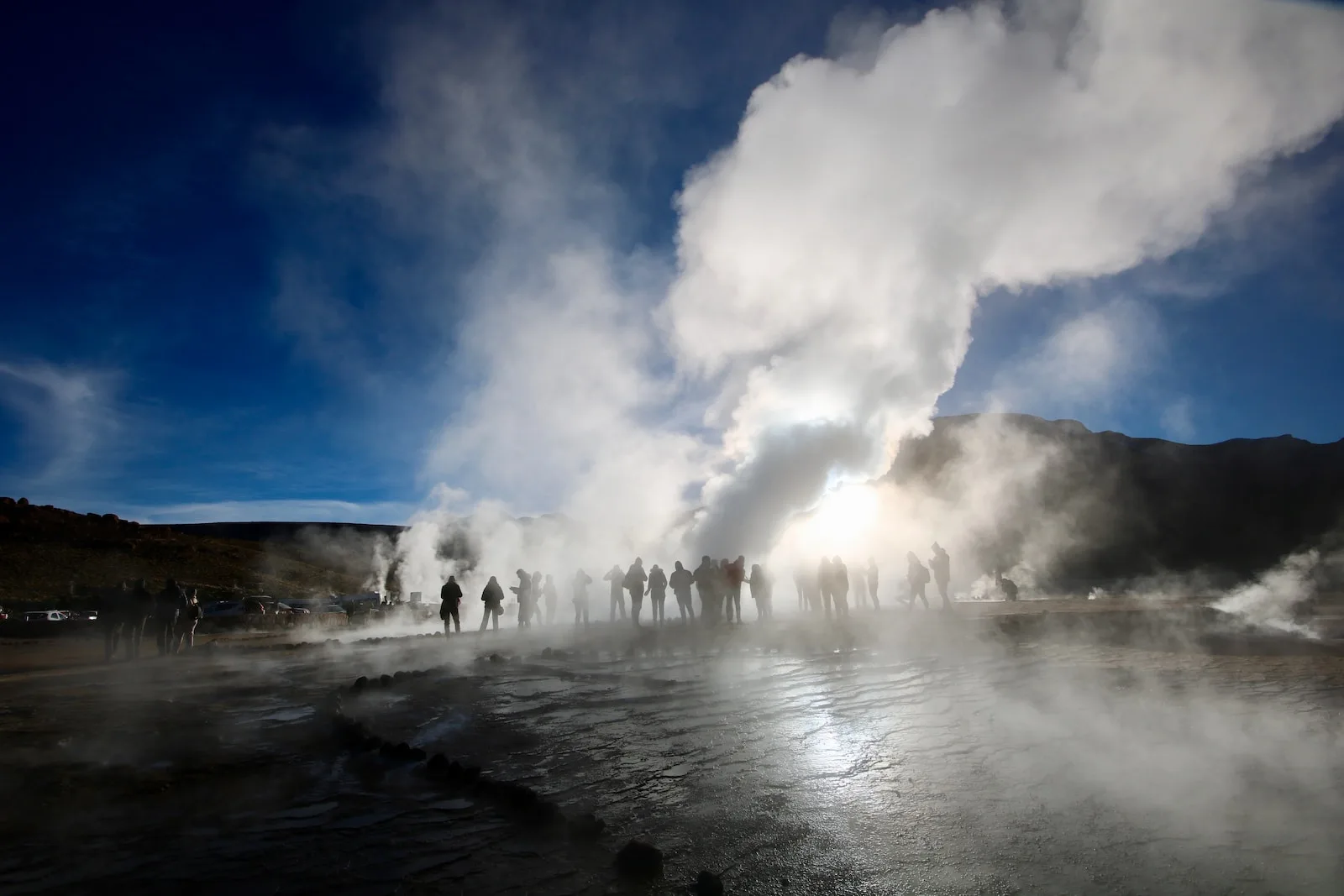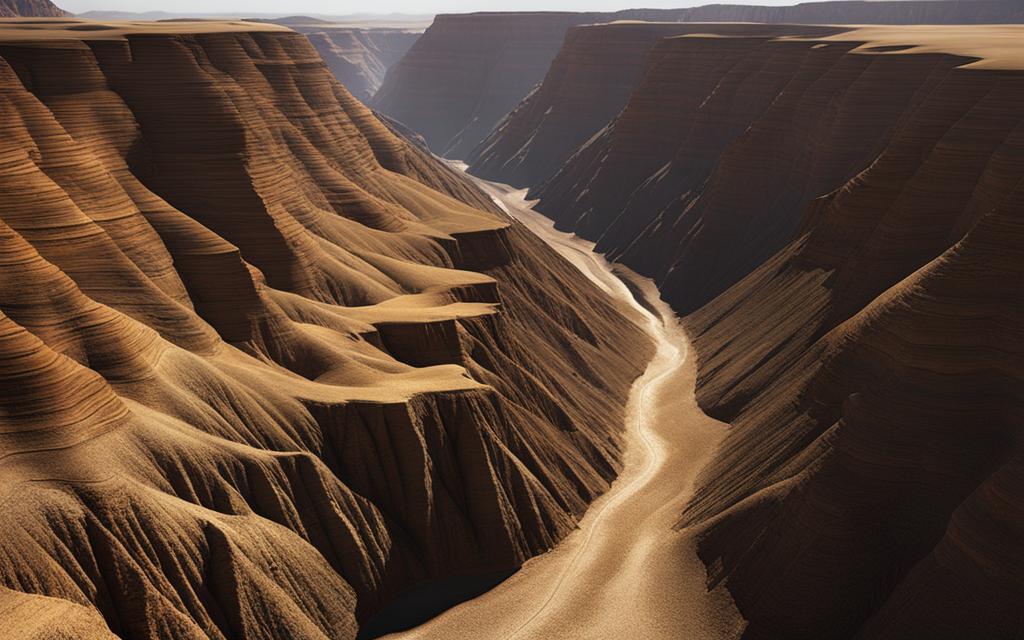An isthmus is a narrow piece of land that connects two larger areas across an expanse of water. It can be a tombolo, which is an isthmus that consists of a spit or bar. On the other hand, a land bridge is an isthmus that connects Earth’s major landmasses. Both isthmuses and land bridges serve as important natural land connections, allowing for migration of people and various species of animals and plants.
Isthmuses and land bridges are fascinating geographic formations that play a critical role in connecting landmasses and shaping our planet. Understanding the differences between these two formations can provide valuable insights into the intricate nature of geography and the interconnectedness of our world. Let’s explore these differences further.
Key Takeaways:
- Isthmuses are narrow pieces of land connecting two larger areas across water, while land bridges connect Earth’s major landmasses.
- Both isthmuses and land bridges serve as crucial natural land connections for migration and the movement of flora and fauna.
- Isthmuses can take the form of tombolos, which are spits or bars of land.
- Land bridges have played significant roles in human history, enabling migration and trade.
- Understanding the differences between isthmuses and land bridges sheds light on the complex dynamics of geography.
Isthmus vs Land Bridge vs Peninsula
An isthmus, a land bridge, and a peninsula are all unique geographic formations, each with its own characteristics and features. Understanding the differences between them can provide valuable insights into the natural world and its interconnectedness.
Isthmus
An isthmus is a narrow strip of land that connects two larger landmasses, typically separated by water. It serves as a land connection, allowing for the movement of people, animals, and plants between the connected areas. Isthmuses can vary in size and shape, from small stretches of land to larger formations. Examples of isthmuses include the Isthmus of Panama, connecting North and South America, and the Kra Isthmus in Southeast Asia.
Land Bridge
A land bridge, on the other hand, is a specific type of isthmus that connects Earth’s major landmasses. These land bridges have played a significant role in the migration of species, including humans, allowing for the movement of flora and fauna between continents. The most well-known land bridges include the Bering Land Bridge, which connected Asia and North America during the last ice age, and the Isthmus of Suez, connecting Africa and Asia.
Peninsula
A peninsula is a piece of land that is surrounded on three sides by water, with one side connected to a larger landform. It differs from an isthmus and a land bridge in that it is not a narrow strip of land connecting two larger areas, but rather a landform that extends into a body of water. The Sinai Peninsula, connecting Africa and Asia, and the Scandinavian Peninsula in Northern Europe are examples of peninsulas.
“Understanding the differences between isthmuses, land bridges, and peninsulas can help us appreciate the intricate nature of our planet’s geography and how it has shaped the movement of life on Earth.”
Major Isthmuses
Several notable isthmuses exist around the world, connecting different landmasses and playing crucial roles in geography and human activities. Below are some of the major isthmuses:
Isthmus of Panama
The isthmus of Panama, located in Middle America, connects North and South America. It is one of the most significant isthmuses globally, serving as a critical land bridge between the Atlantic and Pacific Oceans. The Panama Canal, an exceptional feat of engineering, crosses the isthmus and facilitates maritime trade and transportation.
Isthmus of Tehuantepec
Situated in Middle America as well, the isthmus of Tehuantepec provides a narrow connection between the Gulf of Mexico and the Pacific Ocean. It is an essential geographic feature for trade and navigation, offering a shorter route between the two bodies of water.
Kra Isthmus
Located in mainland Southeast Asia, the Kra isthmus is a narrow land bridge connecting the Malay Peninsula with the mainland. It is of strategic importance for trade, as it offers a shorter route for shipping between the Indian Ocean and the South China Sea.
Isthmus of Suez
The isthmus of Suez, situated between North Africa and Western Asia, connects the Mediterranean Sea with the Red Sea. It is traversed by the Suez Canal, which is a vital waterway for international trade, providing a shortcut between Europe and Asia.
Karelian Isthmus
The Karelian isthmus is located in Europe and connects Finland to Russia. It is notable for its historical significance and has been a site of strategic importance in conflicts between Russia and Finland. The isthmus is an essential land connection in the region.
Isthmus of Corinth
In Greece, the isthmus of Corinth connects the Peloponnese peninsula with mainland Greece. It separates the Gulf of Corinth from the Saronic Gulf and has played a significant role in Greece’s history, as it provided a crucial land route between the two regions.
Isthmus of Catanzaro
The isthmus of Catanzaro is located in Italy and connects the Italian mainland with the Calabria region. It is a narrow strip of land that separates the Ionian Sea from the Gulf of Squillace, contributing to the unique geography of the area.
Isthmuses in Cities
Isthmuses also exist within various cities around the world. For example, Auckland in New Zealand is built on an isthmus between the Pacific Ocean and the Tasman Sea. Manila, the capital of the Philippines, is situated on the eastern shores of Manila Bay, which is part of the larger Luzon Strait isthmus. In the United States, the city of Seattle in Washington state is located between Puget Sound and Lake Washington. Additionally, Madison in Wisconsin sits on the isthmus between Lake Mendota and Lake Monona.
These isthmuses in cities often have unique geographical features and contribute to the cultural and economic development of their respective regions.
| Isthmus | Location | Significance |
|---|---|---|
| Isthmus of Panama | Middle America | Connects Atlantic and Pacific Oceans, Panama Canal |
| Isthmus of Tehuantepec | Middle America | Connects Gulf of Mexico and Pacific Ocean |
| Kra Isthmus | Mainland Southeast Asia | Strategic trade route between Indian Ocean and South China Sea |
| Isthmus of Suez | North Africa and Western Asia | Connects Mediterranean Sea and Red Sea, Suez Canal |
| Karelian Isthmus | Europe | Historical significance, land connection between Finland and Russia |
| Isthmus of Corinth | Greece | Connects Peloponnese peninsula and mainland Greece |
| Isthmus of Catanzaro | Italy | Land connection separating Ionian Sea and Gulf of Squillace |
Canals
Canals are an important feature of isthmuses, serving as advantageous shortcuts for marine transport. They provide a way for ships to bypass longer and more treacherous routes, saving time, fuel, and resources. Here are some notable canals:
Panama Canal
The Panama Canal is one of the most famous canals in the world, connecting the Atlantic and Pacific Oceans. It crosses the isthmus of Panama, which acts as a land bridge between North and South America. The construction of the canal was a major feat of engineering and has played a significant role in international trade and maritime transportation.
Suez Canal
The Suez Canal is another prominent canal, linking the Mediterranean Sea and the Red Sea. It cuts across the western side of the isthmus of Suez, providing a crucial maritime route between Europe and Asia. The opening of the Suez Canal in 1869 revolutionized global trade, shortening the journey between Europe and the Indian Ocean.
Crinan Canal
The Crinan Canal is a smaller canal located in Scotland. It connects Loch Crinan and Loch Gilp, offering a shortcut for boats traveling between the West Coast and the East Coast of Scotland. This canal provides a picturesque route through the Scottish countryside, attracting boaters and tourists alike.
Welland Canal
The Welland Canal is an essential waterway in Canada, connecting Lake Ontario to Lake Erie. It allows ships to bypass Niagara Falls, providing a safe and efficient route for maritime traffic. The Welland Canal has played a significant role in the economic development of the Niagara Peninsula and has facilitated trade between the Great Lakes region and the rest of the world.
| Canal | Location | Significance |
|---|---|---|
| Panama Canal | Isthmus of Panama | Connects Atlantic and Pacific Oceans |
| Suez Canal | Isthmus of Suez | Links Mediterranean Sea and Red Sea |
| Crinan Canal | Scotland | Shortcut for boats in Scotland |
| Welland Canal | Niagara Peninsula, Canada | Connects Lake Ontario to Lake Erie |
These canals have played crucial roles in facilitating global trade, shaping international relations, and opening up new opportunities for economic growth. Their construction and maintenance require significant engineering expertise and ongoing investment.

| Land Connection | Type of Movement | Significance |
|---|---|---|
| Isthmus of Panama | Human migration | Gateway for the first humans entering North America |
| Sinai Peninsula | Human migration, trade | Land bridge between Africa and Asia, crossroad for civilizations |
| Torres Strait | Flora and fauna migration, human migration | Intermittent land bridges for species dispersal and cultural exchange |
| Isthmus of Panama | Trade | Crucial shortcut for shipping between Asia and the Americas |
Geological Speculations
Geologists have long speculated about the existence of ancient supercontinents like Gondwana, which was made up of Africa, South America, Australia, India, and Antarctica. The configuration of these landmasses and the nature of the connections between them remain subjects of ongoing study and debate. It is believed that these regions were linked by either land bridges or isthmuses, but the exact details are still being unravelled.
Understanding the geological similarities between isthmuses and land bridges can provide valuable insights into the past. These formations played a significant role in shaping the Earth’s landscape and influencing the movement of flora, fauna, and even human populations.
“The geological formations of isthmuses and land bridges offer glimpses into the interconnectedness of Earth’s landmasses and the dynamic forces that have shaped our planet over millions of years,” says Dr. Sarah Thompson, a leading geologist in the field of continental drift.
By examining geological evidence and conducting in-depth research, scientists can piece together the puzzle of Earth’s ancient land connections. This knowledge not only enhances our understanding of the past but also helps us make sense of the world we inhabit today.
Note: The image above depicts the supercontinent Gondwana, which existed approximately 510 to 180 million years ago.
Conclusion
In conclusion, isthmuses and land bridges are distinct but related geographic formations that play a crucial role in connecting landmasses across bodies of water. Isthmuses, such as the isthmus of Panama and the isthmus of Tehuantepec, are narrow pieces of land that connect two larger areas, while land bridges, like the Kra isthmus and the isthmus of Suez, connect Earth’s major landmasses.
These natural land connections have facilitated migration, allowing the movement of people, flora, and fauna between different regions. They have also served as important trade routes, enabling the exchange of goods and resources. Additionally, canals built across isthmuses, such as the Panama Canal and the Suez Canal, have provided efficient shortcuts for marine transport.
By understanding the differences between isthmuses and land bridges, we gain insights into the intricate nature of geography and the interconnectedness of our world. From ancient supercontinents to current land formations, geological speculations continue to unravel the past configurations of our landmasses. As we continue to study and explore, we deepen our understanding of the fascinating history and significance of isthmuses and land bridges.
FAQ
What is an isthmus?
An isthmus is a narrow piece of land that connects two larger areas across an expanse of water.
What is a land bridge?
A land bridge is an isthmus that connects Earth’s major landmasses.
How do isthmuses and land bridges differ?
While isthmus and land bridge are related terms, with isthmus having a broader meaning, they are not the same. An isthmus is a land connection between two larger landmasses, while a land bridge is an isthmus connecting Earth’s major landmasses.
What is a peninsula?
A peninsula is a piece of land that is surrounded on three sides by water, attached to a larger landform.
Can canals be built across isthmuses?
Yes, canals can be built across isthmuses, serving as advantageous shortcuts for marine transport.
What are some examples of major isthmuses?
Some examples include the isthmus of Panama, the isthmus of Tehuantepec, the Kra isthmus, the isthmus of Suez, and the Karelian isthmus.
What are some examples of canals?
Examples include the Panama Canal, the Suez Canal, the Crinan Canal, and the Welland Canal.
How do isthmuses and land bridges affect migration and trade?
Isthmuses and land bridges play a crucial role in the migration of people, flora, and fauna. They also serve as important trade routes.
Are there any geological speculations regarding isthmuses and land bridges?
Geologists speculate about the existence of ancient supercontinents, such as Gondwana, which are believed to have been connected by land bridges or isthmuses.
 Skip to main content
Skip to main content


